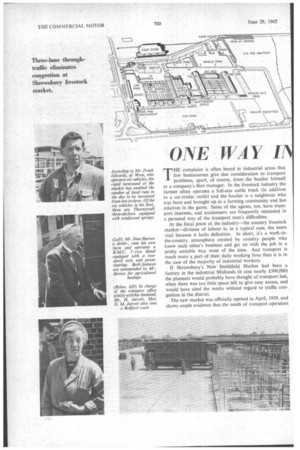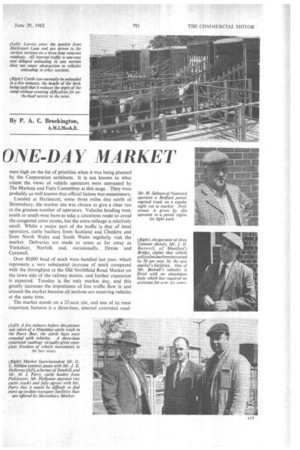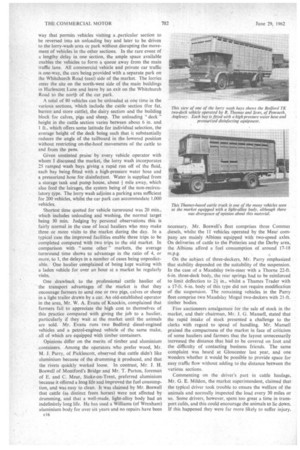ONE WAY I ONE-DAY MARKET
Page 78

Page 79

Page 80

If you've noticed an error in this article please click here to report it so we can fix it.
By P. A. C. Brockington,
THE complaint is often heard in industrial areas that few businessmen give due consideration to transport problems, apart, of course, from the haulier himself or a company's fleet manager. In the livestock industry the farmer often operates a full-size cattle truck (in addition to a car-trailer outfit) and the haulier is a neighbour who was born and brought up in a farming community and has relatives in the game. Some of the agents, too, have transport interests, and auctioneers are frequently reminded in a personal way of the transport man's difficulties.
At the focal point of the industry—the country livestock market—division of labour is, in a typical case, the more vital because it lacks definition. In short, it's a work-inthe-country atmosphere created by country people who know each other's business and get on with the job in a pretty amiable way most of the time. And transport is much more a part of their daily working lives than it is in the case of the majority of industrial workers.
If Shrewsbury's New Smithfield Market had been a factory in the industrial Midlands (it cost nearly £500,000) the planners would probably have thought of transport last, when there was too little space left to give easy access, and would have sited the works without regard to traffic congestion in the district.
The new market was officially opened in April, 1959, and shows ample evidence that the needs of transport operators were high on the list of priorities when it was being planned by the Corporation architects. It is not known to what extent the views of vehicle operators were canvassed by The Markets and Fairs Committee at this stage. They were probably so well known that official liaison was unnecessary.
Located at Harlescott, some three miles due north of Shrewsbury, the market site was chosen to give a clear run to the greatest number of operators. Vehicles heading west, south or south-west have to take a circuitous route to avoid the congested town streets, but the extra mileage is relatively small. Whilst a major part of the traffic is that of local operators, cattle hauliers from Scotland and Cheshire and from North Wales and South Wales regularly visit the market. Deliveries are made to areas as far away as Yorkshire, Norfolk and, occasionally. Devon and Cornwall.
Over 80,000 head of stock were handled last year, which represents a very substantial increase of stock compared with the throughput at the Old Smithfield Road Market on the town side of the railway station, and further expansion is expected. Tuesday is the only market day, and this greatly increases the importance of free traffic flow in and around the market because all sections are receiving vehicles at the same time.
The market stands on a 25-acre site, and one of its most important features is a three-lane, internal concreted road way that permits vehicles visiting a .particular section to be reversed into an unloading bay and later to be driven to the lorry-wash area or park without disrupting the movement of vehicles in the other sections. In the rare event of a lengthy delay in one section, the ample space available enables the vehicles to form a queue away from the main traffic lane. All commercial vehicle and private car traffic is one-way, the cars being provided with a separate park on the Whitchurch Road (east) side of the market. The lorries enter the site on the north-west side of the main buildings in Harlescott Lane and leave by an exit on the Whitchurch Road to the nortli of the car park.
A total of 80 vehicles can be unloaded at one time in the various sections, which include the cattle section (for fat, barren and store cattle), the dairy section and the building block for calves, pigs and sheep. The unloading " deck " height in the cattle section varies between about 6 in. and 1 ft., which offers some latitude for individual selection, the average height of the deck being such that it substantially reduces the angle of the tailboard in the lowered position without restricting on-the-hoof movements of the cattle to and from the pens.
Given unstinted praise by every vehicle operator with whom I discussed the market, the lorry wash incorporates 25 ramped wash bays giving a rapid run off of the fluid, each bay being fitted with a high-pressure water hose and a pressurized hose for disinfectant. Water is supplied from a storage tank and pump house, about mile away, which also feed the•lairages, the system being of the non-recirculatory type. The lorry wash adjoins a parking area sufficient for 200 vehicles, whilst the car park can accommodate 1,000 vehicles.
Shortest time quoted for vehicle turnround was 20 min., which includes unloading and washing, the normal target being 30 min. Judging by personal observations this is fairly normal in the case of local hauliers who may make three or more visits to the market during the day. In a typical case the improved facilities enable three trips to be completed compared with two trips to the old market. In comparison with "some other" markets, the average turnround time shows to advantage in the ratio of 4, or more, to 1, the delays in a number of cases being unpredictable. One haulier complained of being kept waiting with a laden vehicle for over an hour at a market he regularly visits.
One drawback to the professional cattle haulier of the transport advantages of the market is that they encourage farmers to send one or two pigs, calves or sheep in a light trailer drawn by a car. An old-established operator in the area, Mr. W. A. Evans of Knockin, complained that farmers fail to appreciate the high cost to themselves of this practice compared with giving the job to a haulier, particularly if they wait at the market until the animals are sold. Mr. Evans runs two Bedford diesel-engined vehicles and a petrol-engined vehicle of the same make, all of which are equipped with timber containers.
Opinions differ on the merits of timber and aluminium containers. Among the operators who prefer wood, Mr. M. J. Parry, of Picklescott, observed that cattle didn't like aluminium because of the drumming it produced, and that the rivets quickly worked loose. In contrast, Mr. J. H. Boswell of Montford's Bridge and Mr. T. Parton, foreman of E. and C. Mear, Stoke-on-Trent, preferred aluminium because it offered a long life and improved the fuel consumption, and was easy to clean. It was claimed by Mr. Boswell that cattle (as distinct from horses) were not affected by drumming, and that a well-made, light-alloy body had an indefinitely long life. He has used a Williams (of Wrexham) aluminium body for over six years and no repairs have been e16 necessary. Mr. Boswell's fleet comprises three Commet diesels, whilst the 11 vehicles operated by the Mear company are mainly Albions equipped with two-speed axles. On deliveries of cattle to the Potteries and the Derby area, the Albions afford a fuel consumption of around 17-18 m.p.g.
On the subject of three-deckers, Mr. Parry emphasized that stability depended on the suitability of the suspension. In the case of a Maudslay twin-steer with a Thorne 22-ft. 6-in, three-deck body, the rear springs had to be reinforced to limit deflection to 21 in., whilst a Thames Trader with a 17-ft. 6-in. body of this type did not require modification of the suspension. The remaining vehicles in the Parry fleet comprise two Maudslay Mogul two-deckers with 21-ft. timber bodies.
Five auctioneers amalgamate for the sale of stock in the market, and their chairman, Mr. J. G. Mansell, stated that the rapid intake of stock presented a challenge to the clerks with regard to speed of handling. Mr. Mansell praised the compactness of the market in face of criticism of some hauliers and farmers that the layout unnecessarily increased the distance that had to be covered on foot and the difficulty of contacting business friends. The same complaint was heard at Gloucester last year, and one wonders whether it would be possible to provide space for easy traffic flow without adding to the distance between the various sections.
Commenting on the driver's part in cattle haulage, Mr. G. E. Mildon, the market superintendent, claimed that the typical driver took trouble to ensure the welfare of the animals and normally inspected the load every 30 miles or so. Some drivers, however, spent too great a time in transport cafes, and this could encourage the animals to lie down. if this happened they were far more likely to suffer injury.
















































































































































